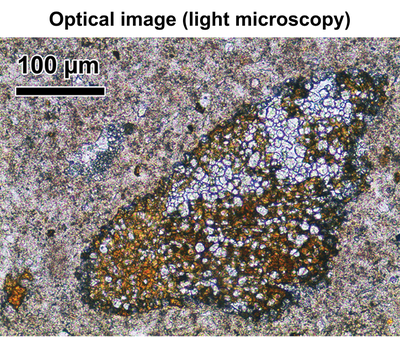Historical Building Materials
Historical building materials, such as cement mortars from 19th century are microstructurally and chemically highly complex. The first application of Raman microscopic imaging to historic cement materials by Dr. Petra Dariz and Dr. Thomas Schmid has revealed the potential of this analytical approach (J. Raman Spectrosc. 44 (2013) 882) and follow-up studies have identified a plethora of silicates, aluminates, aluminoferrites and other phases in historic mortars. Thorough phase analysis provides access to the type of mortar, composition of the raw materials, and conditions (e.g., temperatures) during burning and cooling, and enables tracing of the contemporary technological knowledge. This information has direct implications in the conservation of cultural heritage.


Raman microscopic imaging of a clinker remnant in a 19th-century Roman cement mortar
(adapted from J. Raman Spectrosc. 44 (2013) 882).
This field of research also includes lime (see Combined Raman–luminescence spectroscopy) and gypsum mortars (see Crystallinity mapping).
Selected publications:
T. Schmid, P. Dariz, Heritage 2 (2019) 1662-1683.
P. Dariz, T. Schmid, Mater Charact. 129 (2017) 9-17.
P. Dariz, J. Neubauer, F. Goetz-Neunhoeffer, T. Schmid, Eur. J. Mineral. 28 (2016) 907–914.
T. Schmid, P. Dariz, Constr. Build. Mater. 114 (2016) 506-516.
T. Schmid, P. Dariz, J. Raman Spectrosc. 46 (2015) 141-146.
T. Schmid, P. Dariz, J. Raman Spectrosc. 44 (2013) 882-891.
